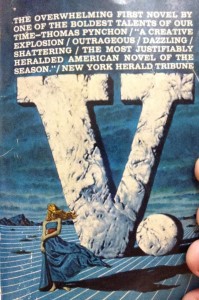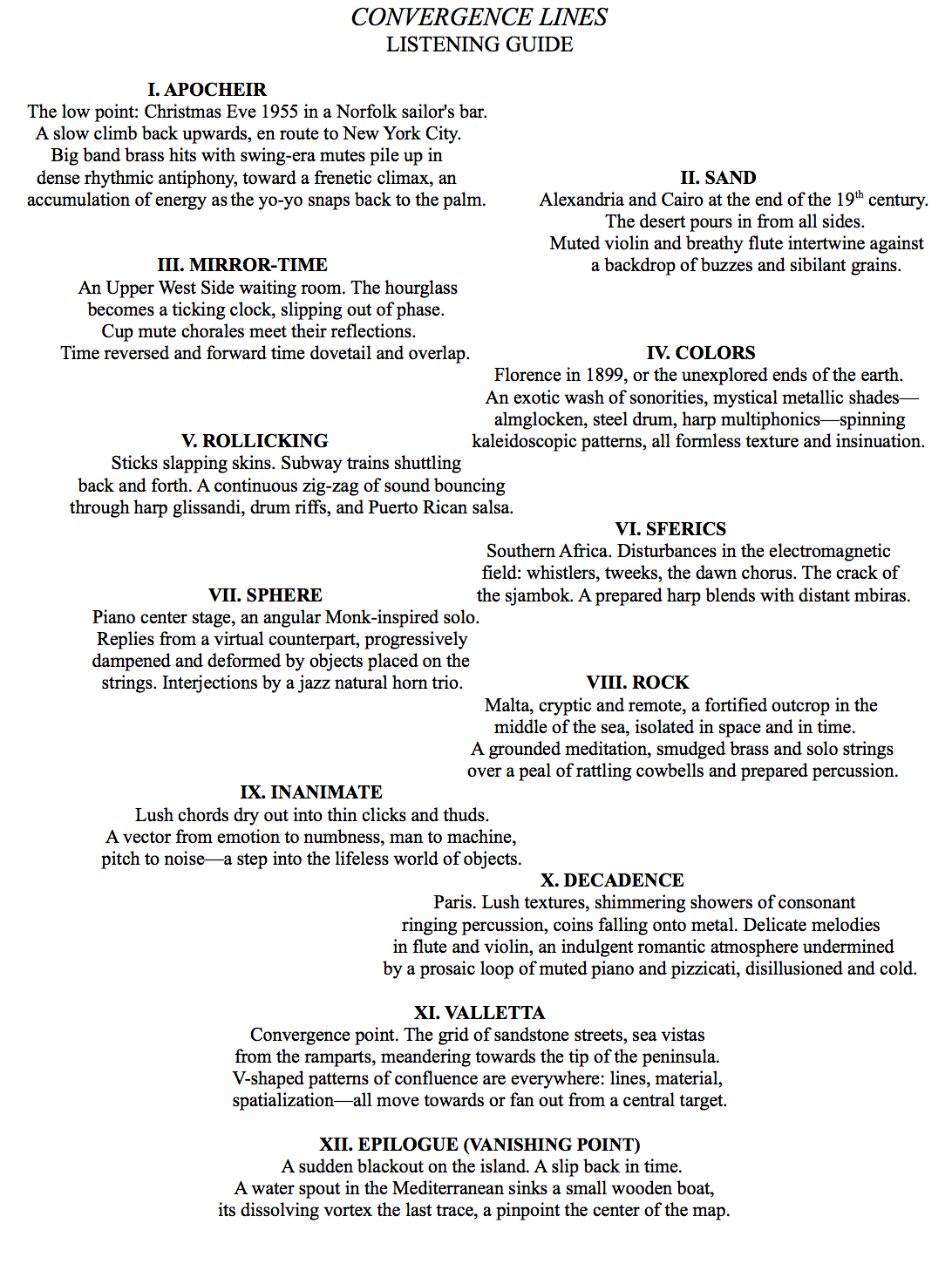Convergence Lines (2013)
for ten players and electronics (flute, clarinet, horn, trumpet, trombone, piano, harp, percussion, violin, bass) [24:00]
This project began with the idea of writing a new piece in 2013 to commemorate the 50th anniversary of Thomas Pynchon’s V.—his ambitious first novel, a huge canvas drawing together a large castof vivid characters, far- flung settings, and a disjointed sense of time.
 Translating postmodern literary devices to music is a longstanding interest of mine, and here the most captivating challenge was to create a musical parallel for its unorthodox structure: two independent strands of narrative that converge towards the end of the book. The first of these, presented in straightforwardchronological episodes, is rooted in 1950’s Manhattan, following the misadventures of Benny Profane and his cohorts in The Whole Sick Crew. The second thread features Herbert Stencil’s quest for a woman who appears in his father’s journals, known only by the initial V. The chapters recounting Stencil’s search jump freely through several eras of the past and multiple exotic locales—Egypt, Florence, Namibia, Paris, Malta—each a vignette with a new atmosphere and a sub- narrative of its own, loosely linked to the others only by a V-named woman who may or may not be the same in each instance…
Translating postmodern literary devices to music is a longstanding interest of mine, and here the most captivating challenge was to create a musical parallel for its unorthodox structure: two independent strands of narrative that converge towards the end of the book. The first of these, presented in straightforwardchronological episodes, is rooted in 1950’s Manhattan, following the misadventures of Benny Profane and his cohorts in The Whole Sick Crew. The second thread features Herbert Stencil’s quest for a woman who appears in his father’s journals, known only by the initial V. The chapters recounting Stencil’s search jump freely through several eras of the past and multiple exotic locales—Egypt, Florence, Namibia, Paris, Malta—each a vignette with a new atmosphere and a sub- narrative of its own, loosely linked to the others only by a V-named woman who may or may not be the same in each instance…
The result is Convergence Lines, a piece in twelve parts, each lasting about two minutes. The odd-numbered episodes follow the New York storyline, often drawing inspiration from the sounds of 50’s American music: big band, salsa, jazz… These generally up-tempo and rhythmically intricate sections, often foregrounding the brass, are connected by shared material and sonorities, creating a sense of development and forward motion. Even-numbered sections on the other hand make no attempt to preserve continuity. Drawing on the novel’s fixation with travel-guide, romantic exoticism, each presents a self-contained, crystallized world with a sonic palette of its own. Material begins to progressively bleed over into adjacent sections as we approach the point of convergence (section XI.), where many previously-heard sounds interact—just before being subsumed by an intrusive wash of white, the closing whirlpool…
 Another significant theme of V. is the widening divide between humanity and the inanimate, between man and machine. One musical translation of this idea isthe use of mutes, preparations, and other unusual objects to physically alter the resonant properties of nearly all of the instruments. The brass play with multiple mutes, including a few functionally obsolete ones from the swing band era such as the cleartone and buzz-wow mutes. In the strings, preparations are even more extensive: paper, felt, and clothespins on the harp, clamps that buzz in the piano’s lowest register, a piece of aluminum foil wrapped around the low C string of the bass. Even percussion instruments are subject to washers and aluminum foil distorting the vibraphone’s resonance, needles and brushes rubbing almglocken and steel drums, thimbles places inside tuned cowbells for a prolonged rattle.
Another significant theme of V. is the widening divide between humanity and the inanimate, between man and machine. One musical translation of this idea isthe use of mutes, preparations, and other unusual objects to physically alter the resonant properties of nearly all of the instruments. The brass play with multiple mutes, including a few functionally obsolete ones from the swing band era such as the cleartone and buzz-wow mutes. In the strings, preparations are even more extensive: paper, felt, and clothespins on the harp, clamps that buzz in the piano’s lowest register, a piece of aluminum foil wrapped around the low C string of the bass. Even percussion instruments are subject to washers and aluminum foil distorting the vibraphone’s resonance, needles and brushes rubbing almglocken and steel drums, thimbles places inside tuned cowbells for a prolonged rattle.
The second musical manifestation of the inanimate is provided by the electronics—a part constructed almost exclusively from prerecorded samples. Using the concatenative synthesis tool CataRT, samples (many of which were recorded in Lyon specifically for this project) are drawn from databases, selected according to search criteria, and retuned in real time to fit into a given pool of microtonal pitches. The result can be anything from a well-timed quick arpeggio to a kaleidoscopic effect, a swirl of changing colors which, when combined with the six-channel, encompassing spatialization, mirrors Pynchon’s breadth with its nearly cinematic scope. Longer sound files, also created from samples in OpenMusic (using SuperVP for retuning and OMPrisma for precise spatial movement). Two other important tools are the score follower Antescofo~, used for a precise rhythmic interplay in the odd-numbered movements, and live descriptor analysis, allowing the timbral characteristics of the live players to pilot the selected color, level, and timing of the playback samples.
I would like to thank the many musical and technical minds who contributed to this project, including Jean Bresson, Max Bruckert, Arshia Cont, José Echeveste, Martin Matalon, Marlon Schumacher, and Diemo Schwarz. Special thanks to James Giroudon at GRAME for providing unparalleled working conditions in the V-shaped city of Lyon, and above all to Christophe Lebreton, without whose expertise this piece would never have seen the light of day.
Convergence Lines was commissioned by GRAME in conjunction with the New Forum Jeune Création, and premiered 23 January, 2014 by the Ensemble Orchestral Contemporain under Pierre-André Valade at the Ultraschall Festival in Berlin. Repeat performances were given on 4 February, 2014 at de Singel in Antwerp and 7 March 2014, as part of the Biennale Musiques en Scène in Lyon.
